 Catalog:

Uzbekistan is a country with an ancient history and the culture having more than 25 centuries, with legendary fantastic Samarkand, Bukhara, Khiva cities. Uzbekistan is: - oriental hospitality and goodwill, exotic, abundance of noisy and picturesque markets; - warm stable weather-10 months a year; - hotels, restaurants, night bars with national colour and European level of service; - fine opportunities for active rest in mountains and desert. Alongside with excursion program you will be able to: - visit the dramatized historical ceremonies and folklore shows; - take pleasure with oriental dances in former Khans harem; - learn to prepare original Uzbek pilaw and round bread; - weave carpets; - make a jug in a workshop of the potter; - pass through picturesque desert on baktrian camel back; - ride on graceful akhaltekin horses; - swim and to fish in huge lakes surrounded by sands; - reach inaccessible mountains on helicopter and to lead picnic on mountain river side; - spend the night in traditional nomads abodes – yurtas; - listen to local akyn songs at a fire under extraordinary bright oriental constellations; - visit exotic national-sports and holidays wrestling, horse wrestling for goat’s carcass, rams, cocks fighting; - taste collection wines; - get original hand-made souvenirs. The tours can be organized in your own dates / any number of pax, cost & conditions are available upon request.
Contact us:
your.climberca@ya.ru +7966 065-53-44 - whatsapp/viber
Author: ClimberCA - International consortium
More info >>>
We are online!
|
 Catalog
Catalog /
Khiva sights
Resources:
78
-
 Ibrahim Khodja Madrasah (1888) - (Khiva District)
www
Ibrahim Khodja Madrasah (1888) - (Khiva District)
www
It is located on the territory of Pahlavan Mahmud collective farm in Khiva district. It was erected by one of Khiva's Khan Muhammad Rahimkhan II's confidants Ibrahim Khodja. The Madrasah is a one-storey building elongated from the south to the north. Though smaller in size than Allah Kuli Khan and Muhammad Rahimkhan madrasahs, it owned much larger vaquf lands than the above mentioned madrasahs.
Rating: 378
-
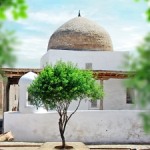 Ak Mosque (1838-1842) - (Ichan-Kala)
www
Ak Mosque (1838-1842) - (Ichan-Kala)
www
The Aq Mosque is part of an ensemble near the eastern gate of Ichan-Kala. Foundation laid in 1657 simultaneously with the Anush Khan bath-houses. Judging by inscriptions on the mosque doors, the building dates back to 1838-42. The inscriptions also mention the names of the Khiva master woodcarvers Nur Muhammad, the son of Adin Kalandar, Kalandar, the son of Seyid Muhammad, The mosque is essentially a mahalli (quarter) - type structure with a domed hall with a three-sided aivan (gallery). The southern wall contains a mihrab-nich orienting the worshipers towards Mecca.
Rating: 376
-
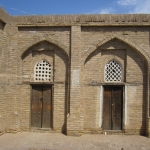 Atajanbay Madrasah (1884) - (Ichan-Kala)
www
Atajanbay Madrasah (1884) - (Ichan-Kala)
www
It is located between Mazari Sharif Madrasah and Russian school. It built by a prosperous Khiva's landowner Atajanbay. The Madrasah has an irregular design. Its contour is sub rectangular viewed from above, elongated in transverse direction from the east to the west, asymmetrical with respect to the entrance in the southern wall. Adjacent to its northwestern wall is Mazari Sharif Madrasah; there is internal passage between the two. These two madrasahs look like a single complex.
Rating: 376
-
 The walls of Dishan-Kala (1842) - (Dishan-Kala)
www
The walls of Dishan-Kala (1842) - (Dishan-Kala)
www
Erected in 1842 by Allakulikhan for protection against attacks from Yomud Turkmen. According to poet and translator Agakhi, Allakulikhan built the walls of Dishan-Kala in 3 years making all his subjects to work unpaid for 12 days every year. More than 200,000 people took part in the wall's construction. The wall had 10 gates. Size: length - 5,650 m; height - 6-8 m; thickness of the foundation - 4-6 m.
Rating: 362
-
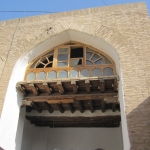 Abdurasulbay Madrasah (1906) - (Ichan-Kala)
www
Abdurasulbay Madrasah (1906) - (Ichan-Kala)
www
The Madrasah is adjoining the southeastern corner of Yar Muhammad Divan Mosque. It was built with the money of Abdurasulbay, nephew of Muhammad Niyaz Mirzabashi (Kamil Khorezmi), a great poet, composer and translator. The Madrasah is elongated along the east-west direction. The entrance part, placed in the center between two yards, consists of two longitudinally oriented domed sections with side exits to Madrasah yards. Two Abdurasulbay's deceased daughters were buried in two hujras.
Rating: 360
-
 Sayid Niyaz Shalikarbai Mosque and Madrasah - (Dishan-Kala)
www
Sayid Niyaz Shalikarbai Mosque and Madrasah - (Dishan-Kala)
www
The complex was built in 1830-40 by a local merchant Sayid Niyaz Shalikarbai who, as is evident from his name - shalikar, meaning a rice grower - specialized on the production and sale of rice. The complex is located in the Dishan-Kala not far from the Palvan-Darvaza gate. Just like the Djuma Mosque, the Sayid Niyaz Shalikarbai Mosque served as a Friday Mosque. It is the city's second mosque after Djuma. The compact complex features a nine-dome winter mosque, a tall four-column avian with a backyard, a two-story pointed madrasah and a tall minaret rising up in between. Open to worshipers.
Rating: 359
-
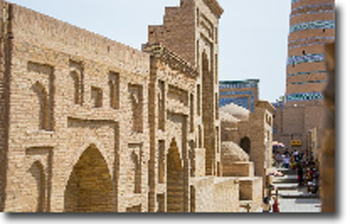 Hojashberdibiya Madrasah (1688-1834) - (Ichan-Kala)
www
Hojashberdibiya Madrasah (1688-1834) - (Ichan-Kala)
www
It was erected in 1688 in Ichan-Kala near the eastern gate Palvan-Darvaza in front of Allah Kuli Khan Madrasah. In 1834 Allah Kuli Khan constructed a new big madrasah, and the existing one was partially pulled down and radically rebuilt. As a result, two small yards formed, and the private madrasah got another name - Hurjun - because it resembled a leather saddlebag called hurjun. The madrasah consists of two yards of different size, a darvaza khana separating them, 16 hujras and domed square-shaped room - darskhana. The madrasah is decorated with carved front doors where the date of its initial construction can be found.
Rating: 355
-
 Bibi Hojar Mausoleum (1846) - (Khiva District)
www
Bibi Hojar Mausoleum (1846) - (Khiva District)
www
It is located in Ruzmat Madaminov collective farm, it is a large memorial complex that includes a mausoleum, winter mosque and cemetery. Bibi Hojar was the mother of great thinker, teacher and valiy-tarosh ("creator of valiys") Najmiddin Kubro. The Mausoleum was built long after her death during the rule of Muhammad Rahimkhan, which is proved by the inscription on the winter mosque column. The Mausoleum and adjacent structures were restored before the 850th anniversary of Nadjmiddin Kubro's birthday.
Rating: 351
-
 Mazari Sharif Madrasah (1882) - (Ichan-Kala)
www
Mazari Sharif Madrasah (1882) - (Ichan-Kala)
www
Is located southeast of Pahlavan Mahmud complex, it was built by foreman Kalandar Kochim on the order of Muhammad Rahimkhan II. Atajanbay Madrasah adjoins Mazari Sharif Madrasah on the eastern side. The entrance to the Madrasah is organized at the southern butt wall through a single vestibule room, which is a cross-shaped domed hall opening onto the yard with a large arch. There is no decor with the only exception of the entrance portal composed of doubled brickwork with inserted green decoration bricks.
Rating: 344
-
 Matrasulboy Mirzaboshi Madrasah (1905) - (Ichan-Kala)
www
Matrasulboy Mirzaboshi Madrasah (1905) - (Ichan-Kala)
www
It is located opposite the western walls of Shirghazi Khan Madrasah. It was built by Muhammad Rasul Mirzabashi, the son of poet and composer Muhammad Niyaz Mirzabashi (Kamil Khorezmi). Muhammad Rasul Mirzabashi was born in 1839, received primary education from his father Kamil Khorezmi and later graduated from a madrasah and Russian school. Kazy Abdullah taught him languages. He perfectly spoke Persian and Arabic and was very good at classic Oriental Poetry. In 1906, with the help of his father he defined tambour notes for the first time in Middle Asia.
Rating: 339
-
 Khorezmshakh Madrasah (1915) - (Dishan-Kala)
www
Khorezmshakh Madrasah (1915) - (Dishan-Kala)
www
It was erected on the order of Khiva's Khan Isfandiyarkhan around the tomb of Khorezmshakh killed in 1622 by Arab Muhammadkhan's son Ilbars. The one-storey Madrasah is elongated from the south to the north. There are a winter mosque and 12 hujras at the Madrasah. In 1918 Isfandiyarkhan was buried in one of the hujras after he had been killed by Turkmens. When the Khanate was abolished, the Madrasah housed a school.
Rating: 326
-
 Kosh-Darvaza (1912) - (Dishan-Kala)
www
Kosh-Darvaza (1912) - (Dishan-Kala)
www
The Northern gate of Dishan-Kala on the road to Urgench, built in the early 20th century. The facades are flanked with three cylindrical towers, with two arch passageways between them and a traditional gallery with merloned parapets on each side. Service rooms are located on both sides of the passageway. The gate's main facades are decorated with horizontal brick mosaic on the towers and on top of the revak. Small domes on the towers are decorated with blue tile. Size: on the plan 25x17 m, height - 9.45 m.
Rating: 325
-
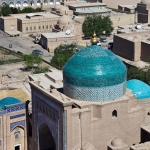 Chilli Avliya Minaret (19th century) - (Dishan-Kala)
www
Chilli Avliya Minaret (19th century) - (Dishan-Kala)
www
It is located on the site of the madrasah bearing the same name near the crossing with the K.Yakubov Street in Dishan-Kala. Made of baked bricks, it has four arched openings and inner stairs decorated with majolica belts. Dimensions: height - 12 m.; foundation - 3.5 m.
Rating: 324
-
 Sayyid Muhammad Makhiruy Mausoleum (19th century) - (Dishan-Kala)
www
Sayyid Muhammad Makhiruy Mausoleum (19th century) - (Dishan-Kala)
www
It is located on Sirchaly aryk in Amir Timur Street. A compound memorial complex consists of three groups of monumental structures including burial sites of several Khiva khans. Sayyid Muhammadkhan, Muhammad Rahimkhan II (Feruz) and his grandson Temurghazi Tura, Isfandiyarkhan's son were buried here. In special cells around the Mausoleum there are tombs of the Khiva khans' descendants, their wives and children. As the legends say, once there lived in these parts a Sufi sheikh called Chadirli Ishan. After his death he was buried here, and the cemetery that grew around his tomb got the name of Chadirly Ishan. In the second half of 19th century, Sayyid Muhammadkhan ordered to erect a mausoleum over the sheikh's tomb. As a result of further construction, the complex turned into the Khiva khans' family crypt. Next to it is the burial site of Islam Khodja.
Rating: 323
-
 Islam Khodja Minaret (1910) - (Ichan-Kala)
www
Islam Khodja Minaret (1910) - (Ichan-Kala)
www
The minaret was built by Islam Khodja, who was Khan's Prime minister. Minaret is a symbol of Khiva, the shape of it ascends to early places-prototypes (Kunya-Urgench XIV) and very narrowed at its top. On the minaret, bands of brick masonry are alternated by a band of a glazed pattern. Standing 56.6m. high, the minaret has a base diameter of 9,5m.
Rating: 323
-
 Yusuf Yassaulbashi (1906) - (Ichan-Kala)
www
Yusuf Yassaulbashi (1906) - (Ichan-Kala)
www
The Madrasah is located opposite Musa Tura Madrasah, it was built by the master Kalandar Kochum with the money of Yussuf Yassaulbashi, head of the Khan's police. Yassaulbashi controlled prisons, took care of the Khan's security, guarded secret documents and was the commander of military units consisting of hired nomadic tribes. The yassaulbashi's office was at the Tash Khauli palace. Yussuf Yassaulbashi Madrasah is a typical madrasah, rectangular if viewed from above, with small guldasta on the corners. Presently this Madrasah houses offices of a Makhallya council.
Rating: 321
-
 Kazy Kalyan Madrasah (1905) - (Ichan-Kala)
www
Kazy Kalyan Madrasah (1905) - (Ichan-Kala)
www
It is located in front of the northwestern corner of Dzhuma Mosque. It was built by Salim Akhun, Khan's Chief Judge. Though this Madrasah is not as large and beautiful as others, it used different education methods. In addition to religious disciplines it taught law and taxation, i.e., legal sciences. Presently there is a Museum of the Musical Art of Khorezm.
Rating: 320
-
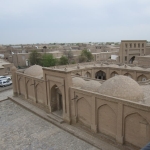 Dost Alyam Madrasah (1882) - (Ichan-Kala)
www
Dost Alyam Madrasah (1882) - (Ichan-Kala)
www
It is located in front of the northeastern corner of Arabkhan Madrasah. The Madrasah was built with the money of Dost Alyam, a jurist at the court of Khiva's Khan Muhammed Rahimkhan II. Mostly jurists and lawyers were trained at the Madrasah. It is a small one-storey building, rectangular when viewed from above, with guldasta towers on the corners and elongated in transverse direction with respect to the central north-south axis. Khudaybergen Haji supervised the construction and Kalandar Kochim was the foreman. Presently the Madrasah houses a woodcarving shop.
Rating: 319
-
 Amir Tura Madrasah (1870) - (Ichan-Kala)
+info
Amir Tura Madrasah (1870) - (Ichan-Kala)
+info
Located in the north part of Ichan-Kala in Tashpolatov Street, it was built by Muhammad Rahimkhan's I son Amir Tura, brother of Sayyid Muhammad Rahimkhan II. Amir Tura was granted a high position of Amirul-ulamo, i.e., leader of ulamo. The madrasah is a large-sized building, two-storied on the facade side and one-storey construction in the yard. It is rectangular when viewed from above, with four guldastas on the corners, and oriented along the longitudinal axis in the west-east direction. The facade was not decorated because Russian troops invaded Khiva. The building was restored in 1983.
Rating: 318
-
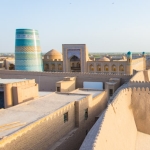 Muhammad Amin Khan Madrasah (1855) - (Ichan-Kala)
www
Muhammad Amin Khan Madrasah (1855) - (Ichan-Kala)
www
The Madrasah is located in the western part of Ichan-Kala. Muhammad Amin-Khan Madrasah is the largest two-storey madrasah not only in Khiva but also in comparison to other buildings in the Middle Asia. In addition to being an important spiritual school was possessing substantial vaquf property and income, it also housed the registry office of the Highest Muslim Court. The architecture of the Madrasah is quite remarkable: here, for the first time in Khiva, comfortable two-room residential hujras were built on the ground floor, as well as loggias in hijras facing the outer facades on the first floor. The madrasah facades are decorated with glazed tiles. Presently it houses a hotel, tourist agency, exchange office, air ticket office and cafe.
Rating: 317
|







 Ibrahim Khodja Madrasah (1888) - (Khiva District)
Ibrahim Khodja Madrasah (1888) - (Khiva District)  Ak Mosque (1838-1842) - (Ichan-Kala)
Ak Mosque (1838-1842) - (Ichan-Kala)  Atajanbay Madrasah (1884) - (Ichan-Kala)
Atajanbay Madrasah (1884) - (Ichan-Kala)  The walls of Dishan-Kala (1842) - (Dishan-Kala)
The walls of Dishan-Kala (1842) - (Dishan-Kala)  Abdurasulbay Madrasah (1906) - (Ichan-Kala)
Abdurasulbay Madrasah (1906) - (Ichan-Kala)  Sayid Niyaz Shalikarbai Mosque and Madrasah - (Dishan-Kala)
Sayid Niyaz Shalikarbai Mosque and Madrasah - (Dishan-Kala)  Hojashberdibiya Madrasah (1688-1834) - (Ichan-Kala)
Hojashberdibiya Madrasah (1688-1834) - (Ichan-Kala)  Bibi Hojar Mausoleum (1846) - (Khiva District)
Bibi Hojar Mausoleum (1846) - (Khiva District)  Mazari Sharif Madrasah (1882) - (Ichan-Kala)
Mazari Sharif Madrasah (1882) - (Ichan-Kala)  Matrasulboy Mirzaboshi Madrasah (1905) - (Ichan-Kala)
Matrasulboy Mirzaboshi Madrasah (1905) - (Ichan-Kala)  Khorezmshakh Madrasah (1915) - (Dishan-Kala)
Khorezmshakh Madrasah (1915) - (Dishan-Kala)  Kosh-Darvaza (1912) - (Dishan-Kala)
Kosh-Darvaza (1912) - (Dishan-Kala)  Chilli Avliya Minaret (19th century) - (Dishan-Kala)
Chilli Avliya Minaret (19th century) - (Dishan-Kala)  Sayyid Muhammad Makhiruy Mausoleum (19th century) - (Dishan-Kala)
Sayyid Muhammad Makhiruy Mausoleum (19th century) - (Dishan-Kala)  Islam Khodja Minaret (1910) - (Ichan-Kala)
Islam Khodja Minaret (1910) - (Ichan-Kala)  Yusuf Yassaulbashi (1906) - (Ichan-Kala)
Yusuf Yassaulbashi (1906) - (Ichan-Kala)  Kazy Kalyan Madrasah (1905) - (Ichan-Kala)
Kazy Kalyan Madrasah (1905) - (Ichan-Kala)  Dost Alyam Madrasah (1882) - (Ichan-Kala)
Dost Alyam Madrasah (1882) - (Ichan-Kala)  Amir Tura Madrasah (1870) - (Ichan-Kala)
Amir Tura Madrasah (1870) - (Ichan-Kala)  Muhammad Amin Khan Madrasah (1855) - (Ichan-Kala)
Muhammad Amin Khan Madrasah (1855) - (Ichan-Kala) 